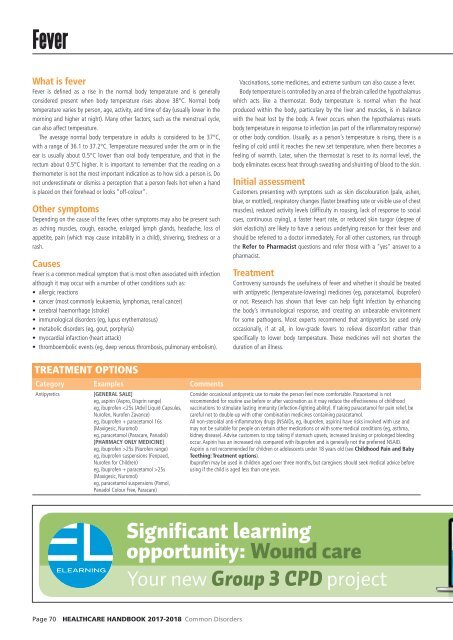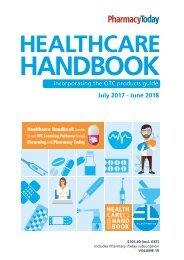2017 HCHB_digital
You also want an ePaper? Increase the reach of your titles
YUMPU automatically turns print PDFs into web optimized ePapers that Google loves.
Fever<br />
What is fever<br />
Fever is defined as a rise in the normal body temperature and is generally<br />
considered present when body temperature rises above 38°C. Normal body<br />
temperature varies by person, age, activity, and time of day (usually lower in the<br />
morning and higher at night). Many other factors, such as the menstrual cycle,<br />
can also affect temperature.<br />
The average normal body temperature in adults is considered to be 37°C,<br />
with a range of 36.1 to 37.2°C. Temperature measured under the arm or in the<br />
ear is usually about 0.5°C lower than oral body temperature, and that in the<br />
rectum about 0.5°C higher. It is important to remember that the reading on a<br />
thermometer is not the most important indication as to how sick a person is. Do<br />
not underestimate or dismiss a perception that a person feels hot when a hand<br />
is placed on their forehead or looks “off-colour”.<br />
Other symptoms<br />
Depending on the cause of the fever, other symptoms may also be present such<br />
as aching muscles, cough, earache, enlarged lymph glands, headache, loss of<br />
appetite, pain (which may cause irritability in a child), shivering, tiredness or a<br />
rash.<br />
Causes<br />
Fever is a common medical symptom that is most often associated with infection<br />
although it may occur with a number of other conditions such as:<br />
• allergic reactions<br />
• cancer (most commonly leukaemia, lymphomas, renal cancer)<br />
• cerebral haemorrhage (stroke)<br />
• immunological disorders (eg, lupus erythematosus)<br />
• metabolic disorders (eg, gout, porphyria)<br />
• myocardial infarction (heart attack)<br />
• thromboembolic events (eg, deep venous thrombosis, pulmonary embolism).<br />
Vaccinations, some medicines, and extreme sunburn can also cause a fever.<br />
Body temperature is controlled by an area of the brain called the hypothalamus<br />
which acts like a thermostat. Body temperature is normal when the heat<br />
produced within the body, particulary by the liver and muscles, is in balance<br />
with the heat lost by the body. A fever occurs when the hypothalamus resets<br />
body temperature in response to infection (as part of the inflammatory response)<br />
or other body condition. Usually, as a person’s temperature is rising, there is a<br />
feeling of cold until it reaches the new set temperature, when there becomes a<br />
feeling of warmth. Later, when the thermostat is reset to its normal level, the<br />
body eliminates excess heat through sweating and shunting of blood to the skin.<br />
Initial assessment<br />
Customers presenting with symptoms such as skin discolouration (pale, ashen,<br />
blue, or mottled), respiratory changes (faster breathing rate or visible use of chest<br />
muscles), reduced activity levels (difficulty in rousing, lack of response to social<br />
cues, continuous crying), a faster heart rate, or reduced skin turgor (degree of<br />
skin elasticity) are likely to have a serious underlying reason for their fever and<br />
should be referred to a doctor immediately. For all other customers, run through<br />
the Refer to Pharmacist questions and refer those with a "yes" answer to a<br />
pharmacist.<br />
Treatment<br />
Controversy surrounds the usefulness of fever and whether it should be treated<br />
with antipyretic (temperature-lowering) medicines (eg, paracetamol, ibuprofen)<br />
or not. Research has shown that fever can help fight infection by enhancing<br />
the body’s immunological response, and creating an unbearable environment<br />
for some pathogens. Most experts recommend that antipyretics be used only<br />
occasionally, if at all, in low-grade fevers to relieve discomfort rather than<br />
specifically to lower body temperature. These medicines will not shorten the<br />
duration of an illness.<br />
TREATMENT OPTIONS<br />
Category Examples Comments<br />
Antipyretics<br />
[GENERAL SALE]<br />
eg, aspirin (Aspro, Disprin range)<br />
eg, ibuprofen 25s (Nurofen range)<br />
eg, ibuprofen suspensions (Fenpaed,<br />
Nurofen for Children)<br />
eg, ibuprofen + paracetamol >25s<br />
(Maxigesic, Nuromol)<br />
eg, paracetamol suspensions (Pamol,<br />
Panadol Colour Free, Paracare)<br />
Consider occasional antipyretic use to make the person feel more comfortable. Paracetamol is not<br />
recommended for routine use before or after vaccination as it may reduce the effectiveness of childhood<br />
vaccinations to stimulate lasting immunity (infection-fighting ability). If taking paracetamol for pain relief, be<br />
careful not to double-up with other combination medicines containing paracetamol.<br />
All non-steroidal anti-inflammatory drugs (NSAIDs, eg, ibuprofen, aspirin) have risks involved with use and<br />
may not be suitable for people on certain other medications or with some medical conditions (eg, asthma,<br />
kidney disease). Advise customers to stop taking if stomach upsets, increased bruising or prolonged bleeding<br />
occur. Aspirin has an increased risk compared with ibuprofen and is generally not the preferred NSAID.<br />
Aspirin is not recommended for children or adolescents under 18 years old (see Childhood Pain and Baby<br />
Teething: Treatment options).<br />
Ibuprofen may be used in children aged over three months, but caregivers should seek medical advice before<br />
using if the child is aged less than one year.<br />
Significant learning<br />
opportunity: Wound care<br />
Your new Group 3 CPD project<br />
Page 70 HEALTHCARE HANDBOOK <strong>2017</strong>-2018 Common Disorders



